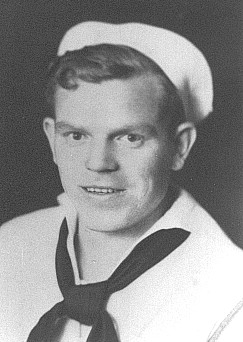
James Terrell “Red” Adams, ca. 1940
(b. 26 Dec 1917, d. 5 Jun 1982)

My uncle, Terrell (“Red”) Adams holds the distinction of being my only family member who was at Pearl Harbor on 7 December 1941. One afternoon, years ago when I was in college, Red and I sat on his back porch as he regaled me with tales of his experiences on that fateful day. Sadly, I did not immediately write down these experiences because I assumed I would hear them again many times in the course of my life. It was only years later, long after Red had passed on, that I learned that he never spoke about that day to anyone else, not even to his closest family members. Why he decided to share that information with me one day is anyone’s guess, but I will record below the details that I remember from that long-ago conversation.
Uncle Red, who joined the U.S. Navy during peacetime, actually had served aboard the USS Arizona for six months in 1940-41, but he was reassigned to the net tender USS Cinchona in August 1941. It was on this ship that he endured the attack. As he related to me, he and a buddy had come topside early that Sunday morning, and Red pulled out a cigarette and asked his friend for a light. About this time they heard some airplanes approaching. Red turned his head briefly to look at them, but as they had been expecting a squadron of American B-17s to arrive soon from the mainland, he assumed that was what these planes were and thus turned back to light his cigarette. His friend (whose name I do not remember whether Uncle Red ever mentioned) opened his lighter, and as he started to bring the flame to Red’s cigarette he paused and said in disbelief, “My God, those are Zeroes!” At that, Red turned back around just in time to see a bomb fall from one of the planes and explode on a barracks full of sleeping men.
Red and his friend immediately manned the .50-cal. machine gun next to which they were standing and, with the friend firing while Red helped feed ammunition belts into the gun, they began firing at the attackers. Because the Cinchona was a relatively small vessel it was spared being a main target in the Japanese attack, but it was strafed several times without causing serious damage. Red said that he and his friend shot up a lot of the Japanese planes that day, but he did not say they successfully brought any down.
After the attack Red was hospitalized briefly for what we today would call post-traumatic stress disorder. Although he was not physically wounded in the attack, he was a first-hand witness to the events of that day, and no doubt he knew personally many of the men who died aboard the USS Arizona, seeing as he had been stationed aboard her mere months before.
Red served aboard the Cinchona for the rest of the war, and after being discharged from the Navy he enlisted in the U.S. Army. I never knew exactly what Red did in the army, but I know it had to do with cryptology (he often spoke of his outfit being known as the “crypto” unit). Somehow he ended up on the front lines during the Korean War, but he did not speak of it very much. The only thing I remember him telling me about those experiences was that he saw the Chinese attack in human waves where only the men in the front had rifles. As they were mowed down, the men behind would pick up the rifles from their dead comrades and charge on, only to have the same thing repeated time and again. Red said he had seen our machine guns fire into these mass attacks until the barrels would grow red hot an begin to droop, making them inoperable.
After Korea, Red served his remaining years in the service Stateside. Upon retiring he came back to Anniston, Alabama, and lived his last few years with his father, John Hoyt Adams, in the Saks community until he died in 1982.